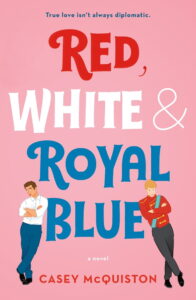
While the mainstream romance genre has had its own share of Prince Charming and his Damsel-in-distress, Red White and Royal Blue by Casey McQuiston changed the scene by bringing in a Prince Charming that was swooning over an equally powerful political contemporary- the first son of America.
Red White and Royal Blue, popularly known by its acronym RWRB, combines in its essence every single aspect of the romantic genre- it is a slow burn with mounting romantic tension, built on the enemies-to-lovers trope, furthered by trials and tribulations that keep the young lovers apart. The crucial factor that separates it from every other romance book in your bookshelf is the representation- a biracial gay son of a single mother, who is also the President of America falling for Prince Henry- a bisexual crown prince of England. Another thing separating the story of the two lovers, however, is the political climate the book is based on. While the grey parts of a romance novel are often villainous characters or unfavourable circumstances- the politics of two of the world’s most powerful nations is the key factor that keeps Henry and Alex from professing their love to the world. While Henry is supposed to maintain his heterosexual, masculine image in front of the world due to the orthodoxy of monarchical discipline, Alex cannot risk a scandal of international relations while his mother is preparing for her re-elections to the White House. The politics that initially united the two, very much became the dividing factor in the story- a metaphor of how the government and politics often steps in the way of LGBTQIA+ couples.

The book takes the reader on a ride of emotions through the storyline. For instance Prince Henry considers himself straight until his feelings for Alex triumph and he comes out as bisexual. It deals with the sensitive journey of closeted gay or bisexual men, and the journey of their coming out and makes it a fun journey, full of headlines and press releases and political drama and a celebration of love. It is a light read for all except it gives queer people (especially adolescent queer kids) who, in an exception, find their own voice through Alex and Henry. Instead of portraying same-sex relationships as plainly sexual, Henry and Alex’s story is raw, genuine, and honest. It gives hope for happily ever after, grand confessions and cheesy dialogues for everyone, be it heterosexual, or homosexual relationships. This is exactly why representation is important- a gay teen somewhere reading RWRB would hang on to the idea of a Prince Charming for themselves, something every teen deserves.
While RWRB is not the first, and definitely not the last book dealing with LGBTQIA+ themes of love and romance, it surely marks a breakthrough in how ‘normal’ everything is; rather than the hypersexualised portrayal of, say, a lesbian relationship. Instead of playing with the prejudices and making the characters caricaturists- Alex and Henry are like every other book couple- you find yourself rooting for them, laughing, and crying with them and loving and losing with them. Moreover, they are both equally strong characters in top political positions, an ideal world setup that can only be created in fiction. None of the characters are stigmatised by being portrayed as ‘effeminate’ or having any of the qualities ‘gay men are supposed to have’ or even given dialogues that make your soul cringe. They are two young boys with immaculate social circles, and ambitious hopes and dreams.
Red, White and Royal Blue is overall a well-rounded book with complex characters that fulfils its objective of creating an imaginary representative world for the young adults who read it. Queer kids, specifically can relate to the main character of the plot of a book instead of relating to the ‘quirky’ side gay character who is best friends with the main lead. They can now, to sound every bit cliched, be the main characters of their own lives- just like the book.

